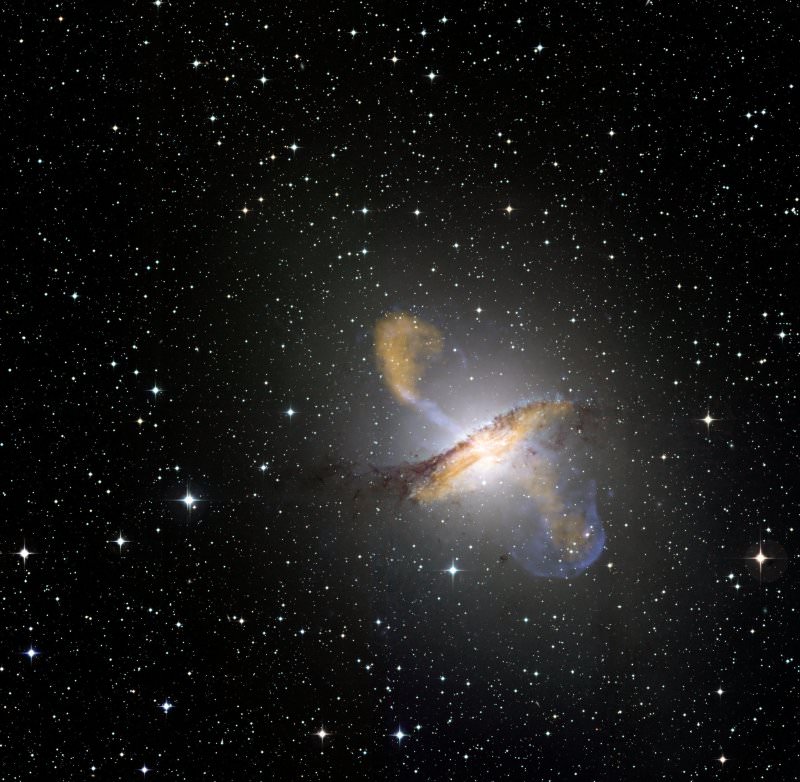[/caption]
There are some interesting dynamics going on with Centaurus A, an elliptical galaxy about 13 million light-years away. This is a very active and luminous region of space and a great disturbance is going on as another spiral galaxy is trying to get in on the action by merging with Centaurus A. But astronomers now have new insight on what causing all the ruckus: a supermassive black hole at the core of Centaurus A. Jets and lobes emanating from the central black hole have been imaged at submillimeter wavelengths for the first time by using the 12-meter Atacama Pathfinder Experiment (APEX) telescope in Chile. By using a combination of visible and X-ray wavelengths, astronomers were able to produce this striking new image. Help me APEX, you are our only hope!
Centaurus A (NGC 5128) is one of our closest galactic neighbors, and is located in the southern constellation of Centaurus. The supermassive black hole is the source of the force: strong radio and X-ray emissions. Visible in the image is a dust ring encircling the giant galaxy, and the fast-moving radio jets ejected from the galaxy center. In submillimeter light, the heat glow from the central dust disc can be seen and also the emission from the central radio source.
APEX was also able to discern – for the first time in the submillimeter – the inner radio lobes north and south of the disc. Measurements of this emission, which occurs when fast-moving electrons spiral around the lines of a magnetic field, reveal that the material in the jet is travelling at approximately half the speed of light. In the X-ray emission, we see the jets emerging from the centre of Centaurus A and, to the lower right of the galaxy, the glow where the expanding lobe collides with the surrounding gas, creating a shockwave.
Source: ESO


OillsMastery — The black hole is actually a “white hole” at the center of the place where the two galaxies intersect. As for gravity, you can’t see it no matter where it is, just its effects. Try jumping off the Earth, unassisted — you can’t see it, you can’t touch it, you can’t taste it, but it’ll pull you right back to the ground in a second.
Just by observing that picture I can see light years full of electric plasma and magnetic fields but absolutely no gravity and no black hole.
Im having trouble seeing the magnetic fields and gravity…wheres that again?
Thats right….Gravity keeps your feet always at ground!!
Yael,
So why do the chemical elements we breathe, ozone, clouds, and the moon defy gravity?
Because they’re lighter than everything else. And since when does the moon defy gravity? If it did it wouldn’t orbit Earth, gravity is what keeps it around Earth just as gravity keeps the planets bound to the sun.
Sakib,
Do you have any idea what you are talking about?
Argon and carbon dioxide are both heavier than nitrogen and oxygen but they defy gravity.
Ozone is heavier than oxygen but it defies gravity.
The moon has defied gravity since the times of Lucretius, Galileo, and Newton. The moon should fall to the Earth at 9.8 m/sec^2. Instead we observe it receding from the Earth at 3.8 cm/year, thus defying gravity.
Absolutely awesome; would never thought the jets and lobes to be so massive. In another vein, why do we respond seriously to these joker bloggers; I guess it’s the same reason some don’t recognize satire: they have a jolly good time tweaking other participants by inserting irrelevant material into the discussion and denying scientific fundamentals, whereupon a goodly portion of the remaining participants take them seriously and attempt to prove them wrong. If I had the time, I guess it would be fun to respond, but……don’t. Guess I just did, but won’t again! MOK
Amazing picture!, although it is just physics. Looking at it I just wondered, if galaxies are surrounded by a halo of dark matter and jets emanating from massive black holes are extremely energetic, any one knows if any studies have been made for possible interactions? (… just a thaught)
Clouds do not defy gravity!
Clouds are less dense than dry air of the same volume. That is why they do not fall from the sky. Upwards vertical motions in the atmosphere also help to counteract the weight of the droplets or ice crystals, helping to hold them up (or make them rise even) in the atmosphere.
Great pic!
13rannon, you are ignoring the fact that the chemical elements in the atmosphere defy gravity.
Sure they do; with a little help from thermal energy.
And the moon and planets and all celestial objects that orbit a larger mass all defy (make that counter) gravity with a little help from the laws of a physical phenomenon called angular momentum.
Will, if thermal energy and angular momentum control the motions of heavenly bodies, why do we study gravity in astronomy?
In case you havent noticed, OilsMastery is our resident troll….please dont feed the trolls people.
I wounder if any lifeforms are left? Beautiful but violent!